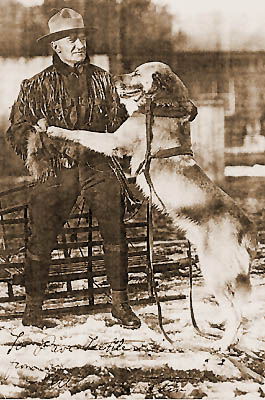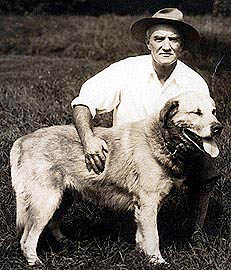ARTHUR TREADWELL WALDEN as a young man was a participant in the Klondike Gold Rush. There he learned to drive a dog team using heavyweight mongrels, giving birth to a lifelong ideal in his mind that ultimately resulted in a new sleddog breed.
Born in Indianapolis, Indiana, on 10 May 1871, he was the son of the Rev. Treadwell Walden, an Episcopal clergyman, and Elizabeth Leighton Walden. He was educated at Chattuck Military School in Faribault, Minnesota. In 1890 he went to Boston, Massachusetts. The Reverend Walden's second wife was related to the Sleeper family of that city; it was through this connection that Arthur Walden first met Katherine Sleeper, daughter of a well-to-do Boston newspaper family, and was hired by her as farm manager. Nevertheless, in March 1896 at the age of 24 he went to Alaska shortly before the Gold Rush. He saw the new century in carrying freight, supplies and mail on the Yukon River, and was the first to bring news of the Klondike gold strike to Circle City in Alaska. While in the Yukon he had worked with an Eskimo dog named "Chinook," who made a deep impression on him. Later, upon his return to New England to live in the Tamworth area, he attempted to recreate the sleddog ideal to which his experiences had given rise.
Walden returned from the Yukon to New England, where he took up life in New Hampshire on the 1300-acre Wonalancet Farm and Inn with his bride Kate Sleeper, whom he had married at the farm in 1902. The farm was in fact hers, bought when her doctor advised her to get out of Boston because of her delicate health. There Walden began his exercise in breeding and training sled dogs. His goal was a friendly, gentle dog that would have power, endurance and speed. On 17 January 1917 he hit an incredible stroke of genetic luck. The mating of a nondescript large yellow male of vaguely mastiff type that he had bought, named Kim, and a direct descendent of Admiral Peary's famous Greenland Husky lead dog Polaris, named Ningo, resulted in three pups. He initially named them Rikki, Tikki and Tavi (from the Kipling "Jungle Book" tales). As he grew up, Rikki produce the traits that Walden had sought; he renamed the dog Chinook, honouring the Eskimo dog that had so impressed him in the Yukon. As an adult, Chinook was a massive 100-pound male in lean condition and a very capable lead dog. Walden commenced breeding Chinook to various females, Belgian and German Shepherds and perhaps to husky bitches also.
Walden tied the development of his dogs to many other enterprises, as he was a born promoter and an energetic man. He introduced his new line of "husky half-breds" to the world in 1920 at the Gorham, New Hampshire, Winter Carnival and straightway began to promote his dogs for diverse purposes: racing, heavy freighting, and recreation. He employed his team to skid power poles on his farm for his hydroelectric project. In the early 1920s he successfully ascended Mount Washington, a 6,288-foot peak in New Hampshire that features gale-force winds more than 100 days out of each year, often combined with severe snowstorms. This and other stunts won considerable local renown for Walden and Chinook. In 1922 he persuaded a local paper company to sponsor the first Eastern International Dog Derby of 123 miles. He is thus credited with bringing the sport of dogsled racing to New England. (With four teams entered, the Walden team was easily the winner of this early race.) In 1924 he spearheaded the founding of the New England Sled Dog Club, which is still in operation today.
As the sport of dogsled racing grew in popularity and competition heightened, Walden began to select Chinook's mates with a view to lighter, faster progeny that still would maintain the friendliness and tractability that characterised his progeny. Finally in 1927 at the Poland Spring, Maine, race, Walden met his match. Going up against Leonhard Seppala, hero of the Nome Serum Run touring the U.S., Walden's and other Chinook teams went down to defeat, despite Seppala's difficulties on the trail with loose teams, wildlife and other distractions to his travel-bored team.
Never a man to remain down for long, Walden heard of Rear Admiral Richard E. Byrd's plans for a major Antarctic expedition. At the age of 56 he was beyond the specified age limit; nonetheless, he applied to join the expedition. Meeting with Byrd, he emerged with the position of lead trainer and driver of dog teams for the expedition, in charge of the other drivers Norman Vaughan, Freddie Crockett, and Eddie Goodale as well. Late in 1927 dogs, drivers and equipment began to be assembled in Wonalancet at the Walden farm and for a year the training of dogs and men and the evaluation of equipment continued.

(Photo courtesy Perry Greene Kennel Historical Collection)
The drivers and 97 dogs went to Antarctica in September 1928. Walden was to be in charge of hauling supplies to support the base camp, "Little America." On Christmas Day 1928 the expedition landed, and for the next three months Walden and nine other drivers freighted 650 tons of gear from the ships to the base camp nine miles inland. Byrd wrote in his book, Little America:
"Had it not been for the dogs, our attempts to conquer the Antarctic by air must have ended in failure. On January 17th, Walden's single team of thirteen dogs moves 3,500 pounds of supplies from ship to base, a distance of 16 miles each trip, in two journeys. Walden's team was the backbone of our transport. Seeing him rush his heavy loads along the trail, outstripping the younger men, it was difficult to believe that he was an old man. He was 58 years old, but he had the determination and strength of youth".But in the middle of the job on January 17, 1929, the venerable old leader Chinook disappeared on his 12th birthday. Despite Walden's searches, Chinook was never found. Walden had lost the great friend of his life. The loss of Chinook affected him deeply; some of the expeditioners claimed they watched Walden age ten years before their eyes at Little America, and Walden himself said in a newspaper interview afterward that he was no longer able to run in front of a sled all day.
Walden returned from Antarctica in 1930 in great debt, despite his wife's personal resources and the Seattle bank savings he had amassed in his Yukon years. The 1929 stock market crash and ensuing bank failures had decimated both their fortunes. On his return, Walden found his delicate wife no longer able to run Wonalancet Farm on her own, having slipped into senility during his absence. Prior to his departure Walden had sold a partnership in Chinook Kennels, then located at Wonalancet Farm, to Milton and Eva B. Seeley. Kate's incapacity had resulted in the Seeleys obtaining a power of attorney, moving her into a small cottage on the property, and leasing the farm to one Walter Jones. Exactly how this came about it unclear, but Walden came home to find the farm occupied by the Joneses under the terms of a lease so strict that he could not even access his own tools and equipment stored there.
Milton Seeley and Walden quarrelled, Walden allegedly telling his antagonist to "take the damned dogs and never set foot on the farm again." Walden sold his remaining interest in Chinook Kennels to the Seeleys. Chinook Kennels was then relocated on property owned by the Seeleys. Walden had earlier given several of Chinook's progeny to Julia Lombard; he had been in the habit of giving her a few choice puppies to raise, the practice giving his breeding programme some protection against a distemper outbreak such as had caused him a setback in 1922-1923. The Chinook breeding programme was thus able to continue at her Wonalancet-Hubbard Kennels under Walden's direction.
After retiring from dog training, Walden continued to write books, all drawing heavily upon the experiences of his "dog-punching" days in the Yukon. His first, the relatively well-known A Dog-Puncher on the Yukon, had been published in 1928 and may have influenced Byrd in his decision to make Walden his lead trainer and driver. Two others, Harness and Pack and Leading a Dog's Life, less well-known, were published after his return to the U.S. Apart from his writing, Walden helped with some sportman's shows put on by Julia Lombard and Ed Moody, and officiated at NESDC races. Generally he led a quiet life after the Byrd Expedition, devoting himself largely to the care of his wife, who by then was unable to care for herself.
On 26 March 1947 a fire broke out in the basement of the Wonalancet farmhouse as Walden's wife was beginning her daily kitchen routine. Her screams aroused Walden, who led her to safety and went back to the kitchen and began drawing buckets of water to fight the fire. He was found dead near the sink, overcome by smoke inhalation, a hero and adventurer to his last breath.


